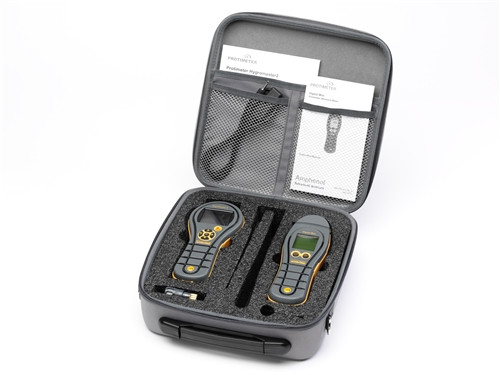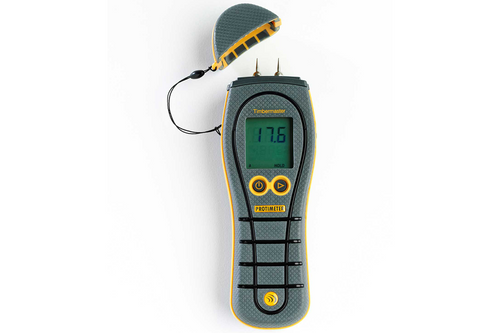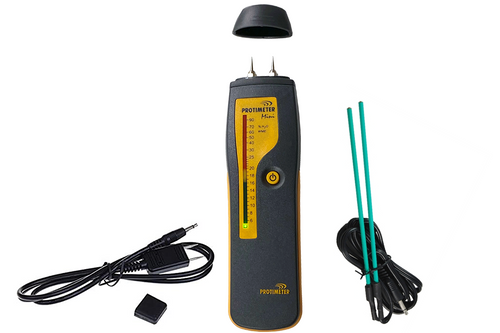Product Description
Protimeter Mini C Pin-Type (PIN ONLY!) Moisture Meter - BLD2001
Click Here for Protimeter Accessories
*We match all prices PLUS an extra 10% of the difference - just call!
Standard Equipment Includes:
- Instrument
- Carrying case
- Instructions
- Cal-check tool
- Wood calibration chart
Features
The Protimeter Mini C is a low cost, highly durable moisture meter designed specifically for the wood floor installation industry. The Mini C is a pin type moisture meter that displays instant moisture content results on its 6 to 30% LED scale. The three-color coded LED scale gives the operator instant information regarding “Dry,” “At Risk” or “Wet” conditions.
Applications
It is important that hardwood finish materials are in moisture equilibrium with the local indoor environment. The Mini C has this information printed right on the label. For example, a 70°F (20°C) environment with an average relative humidity of 60% would require a moisture content of approximately 11%.
The Mini C can also be used to make quick reference readings on concrete sub floors. These readings are surface, but allow the operator to quickly determine the moisture risk. It is a requirement that concrete be tested with an ASTM-approved test such as the F2170 in situ humidity probe test. Please contact InspectorTools for further details.
A range of optional extras are available, including pin extension probes and a hammer electrode for getting measurements up to 1 1/2” (38mm) below the surface.
Benefits
• Helps prevent warping and cracking
• Avoids costly call backs
• Quick and easy to use
• Wide range of wood species calibrations
• Durable design
• Plug-in optional extras
• Auto shut off
Features and Benefits
- Bright LED display for clarity
- Durable and rugged design
- Color coded moisture scale for simple classification of dry, borderline or damp conditions in materials
- Comfortable to hold and easy to use
- Auto shut off for increased battery life
Building Related Questions
What is the Wood Moisture Equivalent (WME) scale as used on Protimeter moisture meters?
- Protimeter moisture meters are calibrated for wood but are also suitable for measuring moisture levels in other materials. They are highly versatile tools for assessing the moisture condition of a wide range of non-conductive materials.
- In wood, the instruments measure the material’s actual percent moisture content (%H2O). When testing material other than wood, the meters measure the wood moisture equivalent (WME) value of the material. WME is the moisture level that would be attained by a piece of wood in equilibrium with the material being tested. As the critical moisture levels for wood are known, WME measurements enable the moisture meter user to establish if materials are in a safe air dry, borderline or damp condition.
What is Relative Humidity (%rh)?
- Relative humidity (%rh) is the degree of saturation – or the amount of water vapor that air contains – relative to the amount it would contain if saturated. This is often expressed as a percentage, so saturated air at a given temperature has 100%rh.
- If air is warmed, the amount of water vapor it could hold at saturation is increased. Consequently, the %rh value falls, even though the actual amount of water remains constant. Similarly, if the air is cooled, the amount of water vapor it can hold is reduced. Consequently, the %rh value rises.
- Condensate forms when there is an excess of water in saturated air.
What is Equilibrium Relative Humidity (ERH)?
- If a dry and absorbent material, such as wood or brick, is placed in a very damp environment (high %rh) it will absorb water and its moisture content will increase. Conversely, absorbent materials with high moisture content will lose moisture to a dry environment (low %rh).
- The movement of moisture from material to environment and vice versa continues until the vapor pressures (within the material and the environment) have equalized. When this condition is reached, the moisture level of a material can be expressed in terms of equilibrium relative humidity (ERH).
- ERH techniques are very useful for assessing if structures are in a dry, borderline or damp condition. For example, when the ERH of a concrete floor falls to 75%, a flooring contractor knows that it has dried sufficiently for a decorative floor covering to be laid.
What is Dewpoint?
- Dewpoint is the temperature at which a sample of air becomes saturated. Condensation forms on surfaces whose temperature is equal to or lower than the prevailing dewpoint temperature.
At what level of WME is a material in a wet or dry condition?
- <18% (Green Zone) - The material is in a Safe Dry condition, moisture related problems of decay/deterioration will not occur.
- 18% - 20% (Yellow Zone) - The material is in a Borderline condition, decay/deterioration may occur under certain conditions.
- > 20% (Red Zone) - The material is in a Wet condition, decay/deterioration is inevitable in time unless the moisture level of the material is reduced.
I suspect my %WME readings in a wall are too high, what should I check?
- has been heavily contaminated by hygroscopic salts, or
- in materials that are conductive by their own nature.
- Artificially high moisture meter readings may be obtained in material that
- If the material being tested is conductive an alternative moisture measurement technique should be used. A hygrometer could be used to measure the material’s ERH, or its actual moisture content could be determined with an Ashworth Instrumentation Speedy tester (see product information).
Range
6-30%
Display
LED bar graph
Resolution
6-20%, 1%; 20-30, 2%
Green—Dry
Yellow—At risk
Red—Excessive
Battery
1 x 9V
Auto shut off
Warranty
24 months on mechanical or manufacturing defects. Does not include wearing part or accessories.
Packaging
• Two replacement pin electrodes
• Pin protection cap
• Calibration check device
• Velcro pouch
• One-year warranty
• Calibration chart for 150 wood species
Weight
Including batteries, 0.330 lb (150 g)
Dimensions
7.02 in x 1.09 in x 1.91 in (180 mm x 28 mm x 49 mm)
Batteries
1 x 9V included











